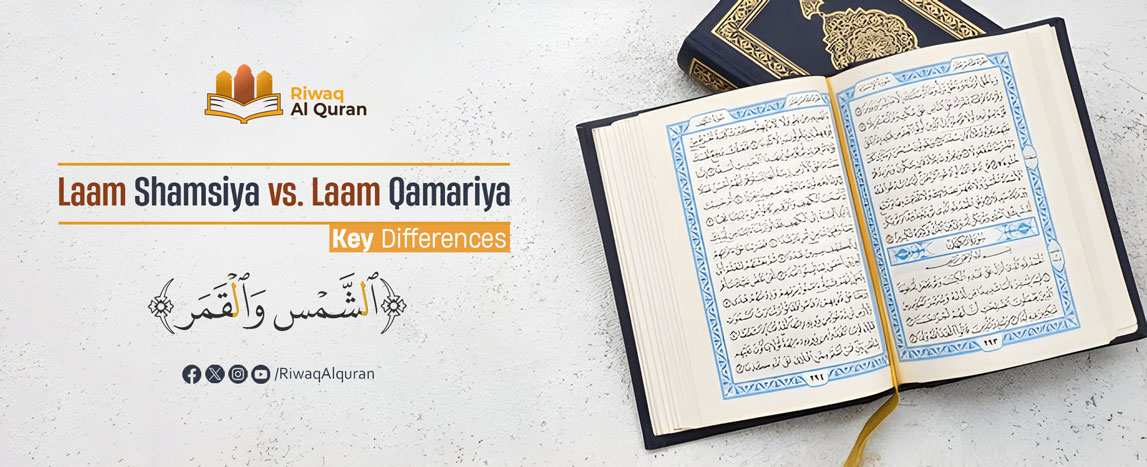In Arabic, the definite article “ال” is pronounced differently based on the 28 letters that follow it, divided into Sun Letters (حروف شمسية) and Moon Letters (حروف قمرية). With Sun Letters, the “Lam” is silent, merging into the next letter with emphasis, like “الشمس” (Ash-Shams). For Moon Letters, the “Lam” is pronounced clearly, as in “القمر” (Al-Qamar).
Learning the rules of Laam Shamsiya and Laam Qamariya is an important step in Learn Arabic Language for Beginners. If you are new to Arabic, it may seem odd, and maybe it should escape your notice, but sometimes you will see Arabic words starting with ‘AL’. This letter changes the noun from an indefinite to a definite one — just like the English word ‘The’.
However, sometimes ‘AL’ is pronounced as ‘A’. Words with ‘AL’ are Laam Qamariya (also known as the Moon letters) while the words with ‘A’ are Laam Shamsiya (also known as the Sun letters or Al Lam Al Shamsiya). In this article, we will walk you through the rules of Laam Shamsiya and Laam Qamariya to make the process of learning the Arabic language easier for you.
Table of Contents
Lam Shamsiya
The Lam Shamsiya لام شمسية is the definite article “ال” in Arabic, which is not pronounced when it precedes specific letters known as الحروف الشمسية (solar letters). Instead of pronouncing the “ال”, the following letter is articulated with شدة (shaddah). This rule applies to the following solar letters: ت، ث، د، ذ، ر، ز، س، ش، ص، ض، ط، ظ، ن، ل.
For example, in the word “الشمس” (ash-shams), the “ال” is omitted, and the “ش” (shīn) is pronounced with a shaddah, resulting in “الشَّمس”.
In essence, the لام شمسية refers to the written form of “ال”, which is not vocalized when followed by a solar letter. Instead, the subsequent letter is pronounced with emphasis, unlike the لام قمرية (lunar “the”), where the “ال” is fully pronounced.
Lam Qamariya:
The Lam Qamariya لام قمرية is the definite article “ال” in Arabic, which is pronounced when it precedes specific letters known as الحروف القمرية (lunar letters). Unlike the لام شمسية (solar “the”), where the “ال” is not pronounced, the “ال” in the لام قمرية is fully articulated.
The lunar letters are: ا، ب، ج، ح، خ، ع، غ، ف، ق، ك، م، هـ، و، ي.
For example, in the word “القمر” (al-qamar), the “ال” is fully pronounced, and the word sounds like “al-qamar.”
In essence, the لام قمرية refers to the written form of “ال”, which is vocalized when followed by a lunar letter, in contrast to the لام شمسية, where the “ال” is omitted and the following letter is pronounced with emphasis.
Comparison Between the Sun and the Moon Letters:
The Sun and the Moon Letters refer to the classification of Arabic letters into الحروف الشمسية (Al-Huruf Ash-Shamsiya) and الحروف القمرية (Al-Huruf Al-Qamariya). This distinction determines whether the “Lam” in the definite article ال is pronounced or silent.
There are 28 consonants in total, 14 out of which are the Sun letters and the other 14 are the Moon letters. Words starting with Sun letters make ‘AL’ sound like ‘A –’, while those starting with Moon letters pronounce ‘L’ as it should really be. In other words, an initial Sun letter right after the definite ‘L’ will double the initial Sun letter and result in the L sound being lost in ‘AL’. As for the Moon letters, they allow the ‘L’ before them to be pronounced fully as ‘AL’.
What is Lam Shamsiya?
Sun Letters are the 14 letters that cause the “Lam” in the definite article ال to be silent. In these cases, the “Lam” is not pronounced, and the next letter, which has a Shadda, is emphasized. For example, in the word الشمس (Ash-Shams), the “Lam” is silent, and the sound flows directly into the “Sh.”
What is Lam Qamariya?
Moon Letters are the 14 letters that allow the “Lam” in ال to be pronounced clearly. In these cases, the “Lam” is distinctly pronounced before the next letter. For example, in the word القمر (Al-Qamar), the “Lam” is clearly articulated before the “Q,” preserving its full sound.


Experience Riwaq Al Quran Classes
Watch real moments from our live sessions at Riwaq Al Quran and see how we bring learning to life. These clips highlight our interactive, student-focused approach designed to keep learners engaged, motivated, and actively involved in every step of their educational journey.
Laam Shamsiya and Laam Qamariya Letters
There are 28 consonants in total, 14 out of which are the Sun letters and the other 14 are the Moon letters. Words starting with Sun letters make ‘AL’ sound like ‘A –’, while those starting with Moon letters pronounce ‘L’ as it should really be.
In other words, an initial Sun letter right after the definite ‘L’ will double the initial Sun letter and result in the L sound being lost in ‘AL’. As for the Moon letters, they allow the ‘L’ before them to be pronounced fully as ‘AL’.
1. The 14 Sun Letters Are as Follows:
Listed below are the sun letters along with some Lam Shmasiya words:
ت، ث، د، ذ، ر، ز، س، ش، ص، ض، ط، ظ، ل، ن.
- The Notebook: الدَّفْتَر
- The Window: النَّافِذَة
- The Man: الرّجل
Practice with the following and discover the words with the Lam Shamsiya:

2. The 14 Moon Letters Are as Follows:
Listed below are the Moon letters along with Arabic examples:
هـ، أ، ب، ج، ح، خ، ع، غ، ف، ق، ك، م، هـ، و، ي.
- The House: الْبَيْت
- The Mosque: الْمَسْجِد
- The Day of Judgment: الْقيامة
Practice with the following and discover the words with the Lam Qamariyah:

Examples of Lam Shamsiya and Lam Qamariya from the Quran
There are several instances in the Quran where you will find Huroof Ash-Shamsiya and Huroof Al-Qamariya. Listed below are some of the prime examples from the Quran:
1. Huroof Shamsiya from the Quran
These examples demonstrate how the Lam blends with the Shadda on the Sun Letters, making the recitation smooth and rhythmic:
- الرَّحْمٰنِ
- النَّاصِرِين
- ٱللَّطِيفُ
- ٱلظَّـٰلِمِينَ
- ٱلطَّآمَّةُ
- السَّمِیْعُ
2. Huroof Qamariya from the Quran
In these examples, the Lam is articulated clearly, preserving its sound and making the recitation precise and deliberate:
- الْفَجْرِ
- الْعِمَادِ
- الْبِلَادِ
- الْفَلَقِ
- الْجِنَّةِ
Difference Between Lam Shamsiya and Lam Qamariya
The key difference in pronunciation between Lam Shamsiya and Lam Qamariya is that in Lam Shamsiya, the “Lam” is silent, and the sound flows directly into the emphasized next letter with a Shadda, such as in الشمس (Ash-Shams). In Lam Qamariya, the “Lam” is pronounced with a clear sound, as in القمر (Al-Qamar), maintaining its distinct sound.
Read more about: Tafkheem And Tarqeeq Of Letters In Tajweed
Importance of learning Lam Shamsiya and Lam Qamariya
Now that we have gone through all the conditions of Lam Shamsiya and Lam Qamariya, let’s have a look at why learning Shamsiya and Qamariya letters, and other Laam basics, is of great importance:
1. Improves Tajweed
By understanding Lam Shamsiya and Lam Qamariya, readers can pronounce words as intended, adhering to the rules of Tajweed. This ensures the recitation of the Quran is precise and beautiful.
2. Enhances Fluency
Mastering these rules helps smoothen the flow of speech by distinguishing between silent and pronounced Lam, making Arabic reading and speaking more fluent and natural.
3. Preserves the Meaning
Accurate pronunciation ensures that the intended meanings of words are conveyed. Mispronouncing the Lam could lead to incorrect interpretations of Quranic verses.
4. Builds a Strong Foundation
For learners of Arabic, especially children and non-native speakers, recognizing the difference between Lam Shamsiya and Lam Qamariya creates a solid foundation for more advanced grammar and phonetics.
5. Connects to the Beauty of the Language
Understanding these rules deepens appreciation for the elegance and logic of the Arabic language, fostering a greater connection to the Quran and its divine structure.
6. Facilitates Accurate Quran Memorization
Learning Lam Shamsiya and Lam Qamariya ensures that the memorization of the Quran is precise. Proper pronunciation helps in retaining the words correctly and reciting them confidently during prayers and lessons.
7. Encourages Attention to Detail
By practicing these rules, learners develop a habit of paying attention to subtle details in pronunciation. This skill benefits not only Quranic recitation but also general Arabic reading and comprehension.
Also, we would advise you to take a look at the other Laam Sakinah Rules in the Quran
Laam Shamsiya and Qamariya in Tajweed
As for the relation between the rules of Laam Shamsiya and Laam Qamariya and Tajweed, the Sun letters in Arabic are pronounced from points of articulation that are close to the articulation point of the letter “Lam” while the Moon letters are pronounced from far points. This would be the reason for merging the laam in the Sun letters.
Regardless of how it is pronounced, the ‘AL’ cannot be spelled differently in written language. A Shaddah sign can be added to the consonant after the Laam to identify Laam Shamsiya. A Sukoon can be placed over it to showcase the Laam Qamariya.
How to Remember Arabic Sun and Moon Letters
Initially, remembering the Sun and Moon letters by mastering the rules of Laam Shamsiya and Laam Qamariya might seem a bit tricky but once you understand the concept, you will be surprised that remembering the Sun and Moon letters is so easy.
The trick of remembering the rules of Laam Shamsiya and Laam Qamariya lies in their names. For instance, الشمس (meaning the Sun) is pronounced as Ash-Shams in Arabic, which means there is no ‘L’ sound in the letter. This implies that all the letters falling under this category will be pronounced without the ‘L’.
On the other hand, القمر (meaning the Moon) is pronounced as Al-Qamar in Arabic, which means there is a significant ‘L’ sound. This implies that all the letters falling under this consonant’s category will be pronounced with the ‘L’.
How to Teach Kids Lam Shamsiya and Lam Qamariya?
Teaching Lam Shamsiya and Lam Qamariya to kids can be fun and engaging if approached with creativity. By simplifying the rules and incorporating interactive activities, children can grasp these Tajweed concepts easily. Here are five effective tips to help you teach them.
1. Use a Fun Story or Analogy
Explain Lam Shamsiya and Lam Qamariya through a simple story. For example, tell them that Lam Shamsiya is shy and hides when it meets the sun letters, while Lam Qamariya is confident and always shows up with the moon letters. This makes the concept relatable and memorable.
2. Introduce a Song or Chant
Create a catchy song or rhyme that lists the Shamsiya and Qamariya letters. Sing it regularly during lessons to help kids remember which letters belong to each group.
3. Use Visual Aids and Flashcards
Make a colorful chart dividing the Arabic alphabet into two groups: Shamsiya with a sun icon and Qamariya with a moon icon. Use flashcards with example words for interactive games like matching the word to the correct category.
4. Practice Through Quranic Verses
Top tip to master lam Shamsiya and lam Qamariya is to choose simple Quranic verses containing Lam Shamsiya and Lam Qamariya words, such as الشمس or القمر. Have kids identify the type of Lam and practice reading the words with proper pronunciation.
5. Incorporate Games and Rewards
Play games like “Spot the Lam,” where kids listen to a word and identify if it’s Shamsiya or Qamariya, or “Letter Sorting,” where they sort letters into sun and moon categories. Reward correct answers to keep learning exciting and engaging


Why Students Love Learning with Riwaq Al Quran
Hear directly from our students about how Riwaq Al Quran Academy has transformed their connection with the Book of Allah. Their experiences reflect the dedication, care, and quality that guide every step of our teaching.
Learn Quran, Arabic And Islamic Studies Online With The Best Native Tutors
Riwaq Al Quran is a comprehensive online platform that offers personalized Quran, Arabic and Islamic Studies Online classes for individuals of all ages and backgrounds.
Their experienced instructors use a structured curriculum to cover Tajweed, Tafsir, and Memorization, providing easy and effective access to learning the Quran.
The advanced online classes allow for seamless communication and interaction between students and teachers. Join Riwaq Al Quran for a deeper connection with the Quran.
We offer several courses such as:
- Online courses for kids.
- Online Quran classes for kids and adults.
- Online Arabic courses
- Online Ijazah courses
- Online Islamic Studies courses.
Here are a sample of our set of Quran Courses that will be helpful for you:
- Online Tafseer Course: Delve into Quranic meanings with our insightful online Tafseer course.
- Noorani Qaida Online: Learn Quranic basics efficiently through our Noorani Qaida online program.
- Online Quran Recitation Course: Enhance Quranic recitation skills through our expert-led online course.
- Online Tajweed Classes: Master Tajweed rules for beautiful Quranic recitation in online classes.
- Quran Memorization Online Course: Memorize the Quran effectively with our specialized online memorization course.
- Online Qirat Course: Explore diverse Qirat styles with our comprehensive online Qirat course.
- Online Quran Classes for Kids: Nurture a love for the Quran in kids through interactive online classes.
Conclusion
While we sign off, we would like to go through the important points we mentioned in this post about the rules of Laam Shamsiya and Laam Qamariya one last time.
In this article, we learned about the consonants of the Arabic language and mentioned that Laam Shamsiya and Laam Qamariya are two broad categories of them. But the main difference between them is that Laam Shamsiya letters make the A sound, while Laam Qamariya letters make the AL sound.
We would also like to end this article with a simple prayer: رَبِّ زِدني عِلمًا
Translation: My Lord! Increase me in knowledge (20:114)


































